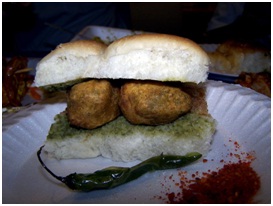The man behind ‘Goli Vada Pav’ – Venkatesh Iyer
Anyone who has visited or lived in Mumbai would have definitely seen or tasted the Vada Pav, which is quick breakfast snack for people on the go.
Vada Pav is also sometimes referred to as the Indian version of the burger, and is popularity due to its taste and convenience. Would a well educated entrepreneur venture in to making or selling vada pavs?
Not really, because although the idea sounds good and there is a demand, no one would dare to start a business of selling vada pavs. One person who dared to pitch in to an entrepreneurial venture of making and selling vada pavs is none other than Venkatesh Iyer, who started this business at the age of 37.
Evolution of Goli Vada Pav
The venture known as ‘Goli Vada Pav’ started with an investment of Rs.1 crore with capital from friends and family members. Since the venture was started in Dombivli near Mumbai, the entire capital was sufficient to buy equipment, a van and for a 500 SF kitchen. In addition some funds were used for running expenses and salaries for employees in kitchen, transportation, etc.
Today, Goli Vada Pav is a multi crore fast food chain with 100 stores in 26 cities across Maharashtra, Karnataka and Tamilnadu. This is not another fast food vendor, but a highly organized set up with strong supply chain, hygienic kitchen and equipment, which maintains high quality and scalability.
Goli Vada Pav has brought in a revolution of enabling a Mc Donald kind of model possible in the ethnic fast food space. This transformation from a small set up to a large chain was achieved after a long but interesting journey that you will be keen to read about.
The Spark of an Idea
Most inventions happen with one small idea, accident, or an attempt to solve a problem or rectify a mistake. This applies to business ideas and innovations as well. In the early days Venkatesh started his career with Centurion Bank, and gradually after 4 years he set up his own financial services firm “Balaji Corporate Services”.
The first stint with retail businesses happened at this firm where he provided consulting services to retailers to raise funds for their business ventures. This motivated Venkatesh to think about starting his own venture at some point of time. Although he was passionate to start his venture, he was still not sure of which venture to get in to.
In 1995 Venkatesh had a a casual conversation with his neighbor, who was the CEO of Kellogs India. During the conversation his neighbor said “No matter what we do, Indians prefer desi food”. This statement got Venkatesh thinking and the idea of start up an ethnic Indian food chain was born.
However, since the types of foods, tastes and other factors were diverse across India, this required some more thought and research. After looking at various options he zeroed in on two options – the idli and vada pav. The idea of the proposed venture was to provide something that can be eaten on the move and easy to carry if required. The vada pav was the final choice, and in January 2003 Goli Vada Pav and its business plan were ready.
The Team
Goli Vada Pav was set up by Venkatesh Iyer, with support from family and friends. His partner Shivdas Menon was an old colleague and friend who joined hands with Venkatesh in this venture. In addition to them there is a huge team of associates who operate at various levels in the organization.
While Venkatesh handles business strategies and future vision, Shivdas overseas fund management, operations and supply chain management. Shivadas’ past experience in corporate finance and Venkatesh’s retail franchisee expertise have been a good combination that has taken the company to great heights.
Outsourcing & Standardization of Food Processing
Goli Vada Pav partnered with Vista Processed Foods, a subsidiary of the US company OSI, one of the world’s largest food processing corporations, which prepares burgers for McDonald’s. Goli Vada Pav outsourced the manufacturing of the potato dumpling to OSI’s fully automated plant near Mumbai.
The plant is certified for hazard analysis and critical control point, a global standard for food safety, and can prepare 100,000 portions in five hours.
Key Takeaways (What we can learn from Goli Vada Pav venture)
Putting standard systems and processes in place benefited the venture in many was as discussed below. In addition we can also take a leaf out of their strategies in terms of product differentiation, branding and various other aspects of business, that most start-ups and entrepreneurial ventures face. Some of the key takeaways are:-
1. Automation of Food Processing
Every stage in the preparation right from cutting, slicing and packing was automated, which saved time and helped cut down on waste.
2. Hygiene Factor
The process was also more hygienic given the automated preparation by machines which avoids manual handling of food and packaging. This is also a good differentiator because vada pav is generally available on the street or at small outlets where hygiene is not given a high priority.
Today, you can get a vada pav from an outlet that is as hygienic as McDonalds or other international fast food chains. So people like top executives, professionals and businessmen of high profile can have hygienic vada pav without compromising on hygiene, health or ambience.
3. Efficient Supply Chain/Procurement System
Given the high inflationary environment getting a reliable source of vegetables and other ingredients at reasonable prices is a big challenge. Goli Vada Pav’s profit margins are largely insulated by the economics of bulk purchasing. Key ingredients such as potatoes, oil and wheat are purchased for 100 stores in bulk, while the remaining perishable ingredients are sourced locally according to the demand requirement.
Given the spiraling onion prices the company also excluded onions , but customers are not complaining. However, some stores/franchisees are allowed to use onion or include them in salads.
4. Distribution
Vada pavs are prepared in a hands-free plant and frozen before they get transported by company-owned reefer vans to various locations. Each location has a Goli Kitchen, which will have a cold room for storage where vadas are stored before they are distributed to the respective Goli stores across the country.
The pav or bread is sourced locally, because it is perishable, and customers would like to have it fresh. For instance in case of Bangalore stores the pav is sourced from vendors such as ITC in Bangalore.
5. Franchisee
Goli Vada Pav has ambitious plans to expand the store count by another one hundred to two hundred stores across new states and cities in India. This requires new models and strategies, and one of them is to have franchisees in select locations or markets to leverage and expand the brand.
The franchisee will have to invest in the initial infrastructure/equipment plus the running costs. The company provides the franchisee with raw materials at nominal rate.
6. Marketing/Promotion
The company started with a simple product to reach masses, so the scope for huge advertising and promotion activities was limited. Like most start ups Goli Vada Pav could not afford expensive media advertising campaigns or branding activities that large corporate engage in. Instead, they smartly used their stores as the front end for showcasing the brand, their logo and identity which people started to recognize. Moreover, as more and more customers liked the product, the word started spreading across various localities bringing in more demand.
The alternate strategy was to use online channels such as Facebook, Twitter, etc to promote the brand and their products. In addition on special events such as Ganesh Chaturti, the company made a huge vada pav base over which Ganesha idol and the event was called “Goli Ganapati”.
Future Roadmap
Today Goli vada pav is a fast growing chain which sells about 100-1300 vada pavs per day per store. The Goli vada pav is the first machine-made vada pav that is standardized and boasts of a longer shelf life. Lets hear about the future plans from the founder himself.
“We plan to add another 50 outlets this year. Our revenue target for the next five years is Rs 180 crore, and presence expanded to 500 outlets. We are also planning outlets overseas. Our Vadas can be shipped to any place in the world” Mr. Venkatesh said.
In future Goli will also experiment with mini kiosks with just 75 SF of space selling only vada pavs with one staff. This would be the simplest module just like any small chat vendors that we see in most cities and towns. There are various other formats that are being conceptualized, discussed and may be tested carefully before they hit the market.
Venkatesh also plans to add pav bhaji to the menu to serve as an evening or dinner snack. This will help stores to add more products in addition to the typical vada pav which is a typical breakfast item.
Moreover, sales of some lunch or dinner items can boost the sales per store and can help in better utilization of capacities and garner higher return on investment.








Leave a Reply